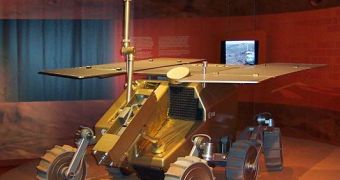After much rumor on the issue, it would appear that the American space agency NASA, and its European counterpart, ESA, will soon reach a conclusive agreement of collaboration for the ExoMars exploration mission, currently scheduled to take off sometime in 2016. The rover, which is about the same size as the American Curiosity Mars Science Laboratory (MSL), will have a vast array of scientific instruments, but its costs are already over budget, and ESA has already sacrificed one of its instruments so as to keep funding in check.
Starting the week of June 29th, the science directors of ESA and NASA are scheduled to begin a series of meetings in England, where they will discuss the future of collaborations between the two space agencies. The goal of the negotiations is to establish the exact terms under which NASA will make an Atlas 5 rocket available to ESA, to transport the small, car-sized rover to orbit. ESA is also interested in learning how the Americans want to fit their Mars Science Orbiter on the same rocket.
The main issue at hand now, Space uncovered, is the fact that NASA is asking the Europeans to drop some of the weight their machine has, so that the Atlas 5 delivery system can send both craft at the same time. But this is a problem for ESA, which was relying on sending more instruments at once to the Red Planet, and then letting go of Mars exploration plans for a while.
“It will not be a simple task for NASA's orbiter to carry the large lander ESA has designed. Detailed studies and analyses are required. Also considered will be (...) the difficulty of the 2016 opportunity for landing due to orbital mechanics and dust storms,” NASA spokesman Dwayne Brown explained for the news outlet in an e-mail. The Europeans are somewhat forced to come to terms with the Americans, because their 850-million-Euro ($1.18-billion) budget does not allow for the complete construction of the ExoMars rover and a launch aboard an Arianespace Ariane 5 heavy-lifting delivery system.
A deal with NASA would take care of this problem, and would allow the entire project to remain roughly within the established cost limits. Last week, at the Paris Air Show, ESA representatives assured European Union officials and other national representatives that the costs would remain the same, so the pressure is now on the space agency to find ways of making good on its promise.
ExoMars could be “the first installment of a larger joint Mars exploration program between both agencies – a joint Mars Architecture looking at missions in 2016, 2018, leading to a joint Mars Sample Return mission sometime in the decade of the 2020s. These plans are predicated on a successful 2016 architecture,” Brown said. “This is a courtship. What we hope to accomplish is something that would be terrific for Europe, and for the United States. For a future mission like Mars Sample Return — even the United States cannot do that alone,” the ESA Science Director, David Southwood, added.

 14 DAY TRIAL //
14 DAY TRIAL //